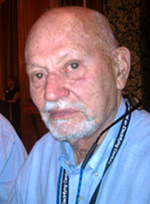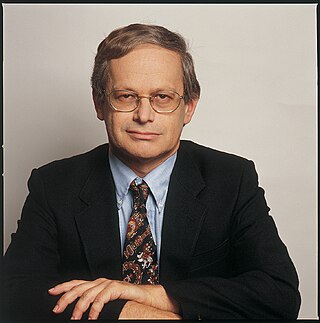
Photonics is a branch of optics that involves the application of generation, detection, and manipulation of light in the form of photons through emission, transmission, modulation, signal processing, switching, amplification, and sensing.
Optica, founded as the Optical Society of America, is a professional society of individuals and companies with an interest in optics and photonics. It publishes journals, organizes conferences and exhibitions, and carries out charitable activities.
Naomi J. Halas is the Stanley C. Moore Professor in Electrical and Computer Engineering, and professor of biomedical engineering, chemistry, and physics at Rice University. She is also the founding director of Rice University Laboratory for Nanophotonics, and the Smalley-Curl Institute. She invented the first nanoparticle with tunable plasmonic resonances, which are controlled by their shape and structure, and has won numerous awards for her pioneering work in the field of nanophotonics and plasmonics. She was also part of a team that developed the first dark pulse soliton in 1987 while working for IBM.

Min Gu is a Chinese-Australian physicist who currently serves as the Executive Chancellor and Professor at the University of Shanghai for Science and Technology. Previously he was Distinguished Professor and Associate Deputy Vice-Chancellor for Research Innovation & Entrepreneurship at RMIT University.
Joseph Wilfred Goodman is an American electrical engineer and physicist.

Robert Louis Byer is a physicist. He was president of the Optical Society of America in 1994 and of the American Physical Society in 2012.
Rod C. Alferness was president of The Optical Society in 2008.

Anthony Michael Johnson is an American experimental physicist, a professor of physics, and a professor of computer science and electrical engineering at the University of Maryland, Baltimore County (UMBC). He is the director of the Center for Advanced Studies in Photonics Research (CASPR), also situated on campus at UMBC. Since his election to the 2002 term as president of the Optical Society, formerly the Optical Society of America, Johnson has the distinction of being the first and only African-American president to date. Johnson's research interests include the ultrafast photophysics and nonlinear optical properties of bulk, nanostructured, and quantum well semiconductor structures, ultrashort pulse propagation in fibers and high-speed lightwave systems. His research has helped to better understand processes that occur in ultrafast time frames of 1 quadrillionth of a second. Ultrashort pulses of light have been used to address technical and logistical challenges in medicine, telecommunications, homeland security, and have many other applications that enhance contemporary life.

Amnon Yariv is an Israeli-American professor of applied physics and electrical engineering at Caltech, known for innovations in optoelectronics. Yariv obtained his B.S., M.S. and PhD. in electrical engineering from University of California, Berkeley in 1954, 1956 and 1958, respectively.
Demetri Psaltis is a Greek-American electrical engineer who was the Dean of the School of Engineering at École Polytechnique Fédérale de Lausanne from 2007 to 2017. Since 2024 he is a professor emeritus at EPFL. He is one of the founders of the term and the field of optofluidics. He is also well known for his past work in holography, especially with regards to optical computing, holographic data storage, and neural networks. He is an author of over 1100 publications, contributed more than 20 book chapters, invented more than 50 patents, and currently has a h-index of 105.
Zeev Zalevsky is an Israeli physicist specializing in optoelectronics. He is a Professor of Electrical engineering and Nanophotonics at Bar Ilan University in Ramat Gan, Israel. He is also a visiting professor in University of Erlangen-Nuremberg at Germany. He is in the management community of the OASIS, The Optical Association of Israel.

Juris Upatnieks is a Latvian-American physicist and inventor, and pioneer in the field of holography.
Abraham Katzir is a Professor of Physics at Tel Aviv University, holding the Carol and Mel Taub Chair in Applied Medical Physics. He is the son of Professor Aharon Katzir, also a scientist, who was killed in 1972 in Ben-Gurion Airport by Japanese terrorists. His uncle, Professor Ephraim Katzir, was the President of Israel.
Brian J. Orr is an Australian scientist known for various experimental and theoretical contributions to molecular and optical physics, including laser spectroscopy and optical parametric oscillators.

David A. B. Miller is the W. M. Keck Foundation Professor of Electrical Engineering at Stanford University, where he is also a professor of Applied Physics by courtesy. His research interests include the use of optics in switching, interconnection, communications, computing, and sensing systems, physics and applications of quantum well optics and optoelectronics, and fundamental features and limits for optics and nanophotonics in communications and information processing.

Donna Theo Strickland is a Canadian optical physicist and pioneer in the field of pulsed lasers. She was awarded the Nobel Prize in Physics in 2018, together with Gérard Mourou, for the practical implementation of chirped pulse amplification. She is a professor at the University of Waterloo in Ontario, Canada.

Harald Schwefel is a German-born physicist currently based in New Zealand. He is an associate professor in the Department of Physics at the University of Otago and a principal investigator in the Dodd-Walls Centre. His research focuses on the interaction of light and matter in dielectric materials, and his speciality is whispering gallery mode resonators (WGMRs), small disks of dielectric which confine and store laser light to facilitate nonlinear interactions. He uses these to generate optical frequency combs and to coherently convert between microwave and optical photons.

Joseph Rosen is the Benjamin H. Swig Professor in Optoelectronics at the School of Electrical & Computer Engineering of Ben-Gurion University of the Negev, Israel.

Yaron Silberberg was an Israeli physicist at the Weizmann Institute of Science where he worked on nonlinear optics, integrated optics, optical solitons, and optical communication technology and physics with ultrashort laser pulses.

Randy Alan Bartels is an American investigator at the Morgridge Institute for Research and a professor of Biomedical Engineering at the University of Wisconsin–Madison. He has been awarded the Adolph Lomb Medal from the Optical Society of America, a National Science Foundation CAREER award, a Sloan Research Fellowship in physics, an Office of Naval Research Young Investigator Award, a Beckman Young Investigator Award, and a Presidential Early Career Award for Science and Engineering (PECASE). In 2020 and 2022, he received support from the Chan Zuckerberg Initiative to develop microscope technologies for imaging tissues and cells.












